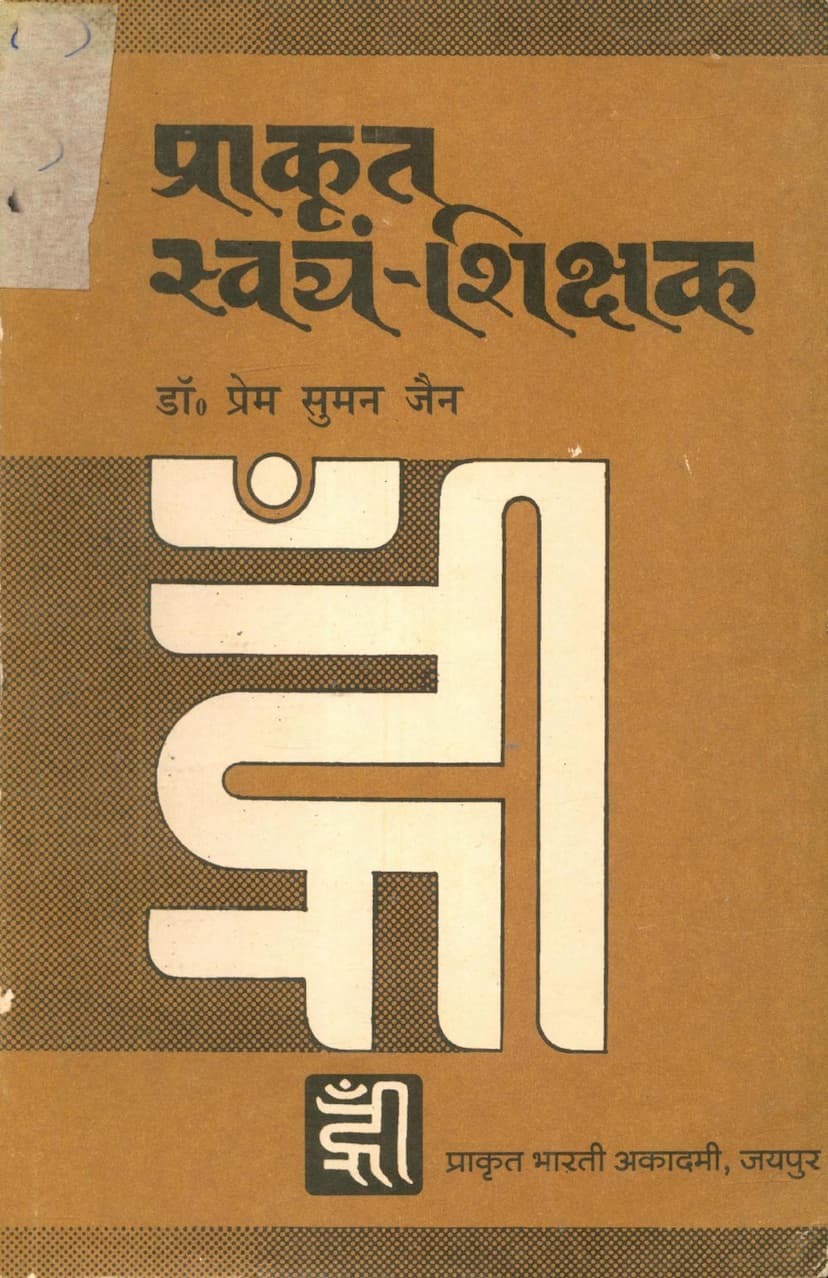Prakrit Swayam Shikshak
Added to library: September 2, 2025

Summary
Here is a comprehensive summary of the provided Jain text, "Prakrit Swayam Shikshak, Khand 1" by Prem Suman Jain:
Book Title: Prakrit Swayam Shikshak, Khand 1 (Prakrit Self-Teacher, Volume 1) Author: Prem Suman Jain Publisher: Prakrit Bharati Academy, Jaipur Edition: Third Edition (Reprinted in 1982, Third Edition 1998)
Overall Purpose and Philosophy:
"Prakrit Swayam Shikshak, Khand 1" is a foundational grammar book designed for self-learning the Prakrit language. Its core philosophy is to make Prakrit accessible to Hindi speakers without requiring prior knowledge of Sanskrit. The book emphasizes a scientific and modern approach to teaching, aiming to foster learning through practice and gradual assimilation of rules, rather than rote memorization. It bridges the gap between traditional Prakrit grammar, which often relies on Sanskrit, and the needs of contemporary learners.
Key Features and Strengths:
- Self-Paced Learning: The title "Swayam Shikshak" (Self-Teacher) highlights its primary goal of enabling individuals to learn Prakrit independently.
- Hindi Medium: The book is written in Hindi, making it accessible to a large audience in India.
- Scientific and Modern Methodology: It adopts a systematic approach, introducing grammatical concepts through examples and exercises, with rules presented at the end of lessons to avoid disrupting the learning flow.
- Gradual Progression: The book starts with basic elements like pronouns and verbs and progresses through various grammatical cases, tenses, and sentence structures.
- Vocabulary Building: It aims to equip learners with a substantial vocabulary of approximately 600 Prakrit words, 200 verbs, and numerous adverbs, adjectives, and pronouns.
- Traditional Foundation: While modern in its pedagogy, the author has maintained the historical context and tradition of Prakrit grammar.
- Focus on Essential Forms: To simplify learning, the book primarily introduces one common form of Prakrit words and verbs, acknowledging that alternative forms can be studied later.
- Practical Application: The text includes numerous example sentences, translation exercises from Hindi to Prakrit, and later sections with "padyas" (verses) and "gadyas" (prose) for practical application, with word meanings provided.
- Comprehensive Coverage: The book covers essential Prakrit grammar, including:
- Introduction to Prakrit language (स्वरूप एवं विकास - Form and Development)
- Pronouns (सर्वनाम)
- Verbs (क्रियाएँ) across different tenses (present, past, future, imperative/desire)
- Nouns (संज्ञा) and their declensions (cases like nominative, accusative, instrumental, dative, ablative, genitive, locative, vocative)
- Compound verbs (संज्ञार्थक क्रियाएँ)
- Adjectives (विशेषण)
- Passive voice (कर्मणि प्रयोग)
- Causative verbs (प्रेरणार्थक क्रिया-प्रयोग)
- Verbal nouns (कृदन्त) and adverbial participles (हेत्वर्थ कृदन्त)
- Sandhi (संधि-प्रयोग)
- Samasa (समास-प्रयोग)
- Alternative usages (वैकल्पिक प्रयोग)
- A compilation of Prakrit verses and prose (पाइय-पज्ज-गज्ज-संगहो)
- A Prakrit-Hindi glossary (शब्दार्थ)
- Enrichment in Later Editions: The third edition includes an essay on the "Form and Development of the Prakrit Language" and a brief introduction to major Prakrit grammarians, enhancing its academic value.
Content Overview (Based on the Index and Sample Pages):
The book is structured into numerous "Paath" (lessons), covering a wide range of grammatical topics. Some key areas explored include:
- Pronouns: Introduction and usage of personal pronouns (I, you, he/she/it, they) and demonstrative pronouns (this, that) and interrogative pronouns (who).
- Verbs: Conjugation of verbs in various tenses (present, past, future, imperative/potential) for different persons and numbers.
- Nouns: Declension of masculine, feminine, and neuter nouns through the eight cases (vibhakti), with explanations of case endings and usage.
- Special Verb Forms: Discussion of verbal participles (kṛdanta) used as adjectives and infinitive forms (hetvartha kṛdanta) expressing purpose.
- Grammatical Concepts: Explanation of passive voice, causative verbs, and their applications.
- Syntactic Elements: Introduction to sandhi (vowel and consonant changes in word combination) and samasa (compound words).
- Contextual Learning: The inclusion of "Paiy-Pajj-Gajj-Sangaho" (Compilation of Prakrit Verses and Prose) allows learners to apply their knowledge to actual literary pieces.
- Grammarians and Language History: The introductory sections and the appendices provide context on the evolution of Prakrit and the contributions of its grammarians.
Contribution and Significance:
"Prakrit Swayam Shikshak" is recognized as filling a significant gap in Prakrit language learning resources. Its accessibility and systematic approach have contributed to the promotion and study of Prakrit in educational institutions like Sukhadia University, Udaipur, and are also reflected in its adoption by examination boards. The book empowers learners to engage with Prakrit literature and unlock the vast reservoir of Jain and other ancient Indian texts written in the language. The publisher's commitment to reprinting and improving the edition underscores its value and popularity.